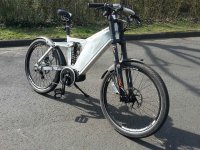Hey Gary, thanks for that language hint!
The Bafang motor has the CE approval and the CA has something similar. I don't know about the Phaserunner and the biggest problem will be the chinese battery. If I don't solve the two last problems, the whole procedure could cost more then 1000€! If I have those papers, it will be around 400€. Still a lot of money.

The problem is that they can take your car driving license for riding something like that...I already had contact to a TÜV-guy. I could make the bike street legal. It's a question of money. He told me that if my electrical components have no proper CE-sign, he has to test them for electromagnetic emissions (don't know the proper term in english), which is an expensive procedure. The mechanical part (chassis, brakes etc.) are easier to legalize,concerning that, he has more freedom. The magura parts are already street legal from the start and I feel confident about the chassis.garyal1 said:Looks to me like you will have a speeding ticket before too long.
The Bafang motor has the CE approval and the CA has something similar. I don't know about the Phaserunner and the biggest problem will be the chinese battery. If I don't solve the two last problems, the whole procedure could cost more then 1000€! If I have those papers, it will be around 400€. Still a lot of money.
When thinking about it I realized that it makes no sense, that a certain parameter causes a communication error. That would be a quite irrational explanationgaryal1 said:I have found that the best way to avoid the dreaded Comm error when saving parameters is to 1st read the PR, then make the changes and export it to an XML file. Then shut down the PR by disconnecting battery. Then reconnecting battery and importing from XML and using save parameters without having first used read parameters. on the fresh startup of the PR. Don't ask me why, but by doing this I get a 50% success rate compared to 0% success rate.







